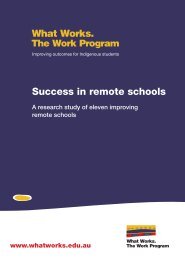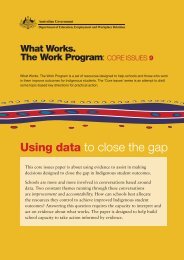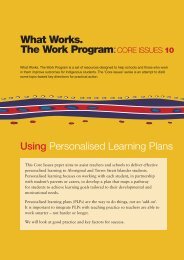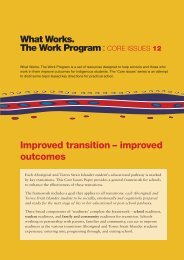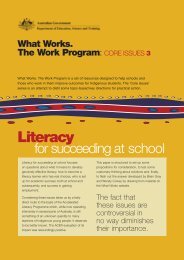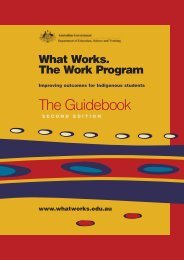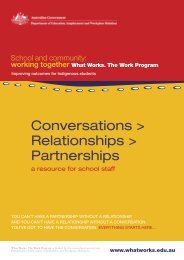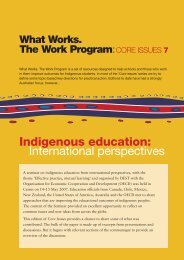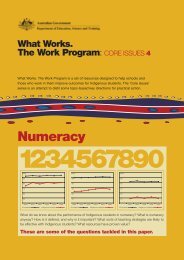SCIENCELife <strong>and</strong> LivingConcept In Year 1the student:In Year 2the student:In Year 3the student:In Year 4the student:In Year 5the student:In Year 6the student:In Year 7the student:In Year 8the student:In Year 9the student:Structure <strong>and</strong>FunctionThere is a relationshipbetween the structure<strong>and</strong> function of livingthings <strong>and</strong> this is thebasis <strong>for</strong>underst<strong>and</strong>ing lifemaintainingprocesses• Knows that things areliving or non-living <strong>and</strong>gives examples of each(e.g. animals, people areliving <strong>and</strong> rocks, soil,clouds <strong>and</strong> sun are nonliving).• Knows that there are manydifferent types of livingthings including insects,birds, fish, worms, plants[ ∗ plants are not living].• Recognises that peoplehave different body parts<strong>and</strong> can say what they are(e.g. says “that is the head<strong>and</strong> that is the arm”). HPE• Can use a h<strong>and</strong> lens ormagnifying glass toobserve the structure ofliving things.• Sorts living things into twogroups: plants or animals.• Gives examples of whatliving things do that makethem ‘alive’ (e.g. eat,grow <strong>and</strong> move).• Knows that all livingthings die <strong>and</strong> that thismeans they can’t ‘eat,grow, <strong>and</strong> move’ anymore.• Recognises <strong>and</strong> names awide variety of plants <strong>and</strong>animals in terms of theirsize, shape <strong>and</strong> colour.• Knows that living thingsare more than just commonplants <strong>and</strong> large l<strong>and</strong>animals (mammals) <strong>and</strong>recognises those that aren’t(e.g. fungi, seaweed, moss,seeds, snakes).• Matches living things’body-parts with groups ofliving things (e.g. matchesfins with fish, wings withbirds, shells with snails)<strong>and</strong> can describe thesedifferences (e.g. says“birds use their wings tofly”).• Can use a h<strong>and</strong> lens ormagnifying glass toobserve the structure ofliving things <strong>and</strong> c<strong>and</strong>escribe what they see(e.g. says “I can see littlelines in the wing of thedragonfly”).• Sorts living things into twogroups: plants or animals<strong>and</strong> makes simplestatements about the basis<strong>for</strong> their sorting (e.g. says“plants are green <strong>and</strong> haveleaves” <strong>and</strong> “animalsmove”).• Distinguishes betweenliving <strong>and</strong> non-livingthings using basic criteria(such as movement,growth, feeding ornutrition, breathing,reproduction, reaction) <strong>and</strong>knows that all living thingsappear to do all thesethings [ ∗ only things thatmove are alive].• Knows that it is thesethings that living things‘do’ that help them to liveor survive <strong>and</strong> that theyhave special features orstructures that help them todo these things (e.g. fins<strong>and</strong> legs help animals tomove to find food; leaveshelp plants to make food;lungs help animals tobreathe).• Gives examples of thingsthat are living <strong>and</strong> nonliving<strong>and</strong> can distinguishbetween ‘dead’ <strong>and</strong> nonliving(e.g. a rock is notdead).• Identifies obvious featuresof a variety of plants <strong>and</strong>animals (e.g. says“animals have eyes <strong>and</strong>ears <strong>and</strong> some have legs<strong>and</strong> arms, hair <strong>and</strong> fur” or“plants are usually green<strong>and</strong> have leaves, stems,<strong>and</strong> sometimes flowers”).• Describes the features ofstructures that all livingthings of the same typehave in common (e.g. says“all dogs have legs, nose,eyes, ears <strong>and</strong> a tail”).• Sorts <strong>and</strong> classifies similaranimals <strong>and</strong> plants intogroups <strong>and</strong> says why theyare similar or different(e.g. says “These birds aredifferent because theseones have long legs <strong>and</strong>these have short legs”).• Recognises that someliving things may notappear to do all the thingsthat other livings things do(e.g. says “those thingsdon’t move/breathe”) butknows that living things donot have to move orbreathe to be alive.• Compares the needs ofdifferent animals such asbirds, fish, horses, people<strong>and</strong> insects, <strong>and</strong> knowsthat living things vary intheir needs with respect toshelter (e.g. says “animalswith fur don’t need asmuch shelter as thosewithout fur”).• Recognises similarities <strong>and</strong>difference between a widevariety of living things(e.g. says “most animalshave ears even though youcan’t always see them”<strong>and</strong> “all living things‘breathe’ but some don’thave noses – insectsbreathe through theirbodies”).• Recognises similarities <strong>and</strong>difference between a widevariety of plants (e.g. says“some have leaves that arespongy or like needles <strong>and</strong>some have prickles,flowers or cones”) <strong>and</strong>speculates on why.• Sorts things into group of‘living’ <strong>and</strong> non-living’<strong>and</strong> ‘dead using basiccriteria as well as visualaids such as h<strong>and</strong> lens <strong>and</strong>magnifying glass.• Sorts living things intogroups based on types ofmovement, <strong>and</strong> recognisessimilarities in structure(e.g. says “birds, bats <strong>and</strong>insects can fly <strong>and</strong> thingswith legs can run”).• Identifies structures ofliving things <strong>and</strong> describesthe relationship betweenstructures (as being relatedto meeting their survivalneeds) <strong>and</strong> function (e.g.ducks have webbed feet tohelp them swim, a bird’sbeak helps it to cracknuts).• Knows that animals usedifferent senses to helpthem find food, <strong>and</strong> thattheir senses might bespecialised <strong>for</strong> this purpose(e.g. night animals haveeyes that see well in thedark, dogs have a keensense of smell).• Knows that some plantshave parts that arespecialised to live indifferent environments(e.g. flowers to attractbees, thick trunks toprovide stability, pricklesso they won’t be eaten).• Sorts living things intogroups based onobservable characteristicssuch as structures <strong>and</strong>features (e.g. ducks,platypus <strong>and</strong> seagulls havewebbed feet, plants haveleaves <strong>and</strong> stems).• Underst<strong>and</strong>s thatorganisms have differentfeatures that suit them tothe environment in whichthey live <strong>and</strong> can compareliving in water to living onl<strong>and</strong> in terms of thedem<strong>and</strong>s of theenvironments. Knows thatfish have gills <strong>and</strong> thissuits them to a waterenvironment whilemammals breathe withlungs, suiting them to al<strong>and</strong> environment(mammals like dolphins<strong>and</strong> whales need to cometo the surface to breathe).Compares plants <strong>and</strong>animals that are suited tolive in water with thosesuited to live on l<strong>and</strong> <strong>and</strong>says what features suitthem to living in theseenvironments (e.g. says“fish wouldn’t be able tomove on l<strong>and</strong> <strong>and</strong>octopuses have moist skinso they’d dry out if theywere out of water).• Compares animal size,body covering (fur,feathers <strong>and</strong> skin) presenceor absence of limbs (legs,fins, wings) <strong>and</strong> relatesthese features to wherethey live <strong>and</strong> how theyfind food.• Knows that behaviours <strong>and</strong>appearances of organismscan help them to survive intheir environments (e.g.camouflage, hibernation,migration).• Has a simpleunderst<strong>and</strong>ing ofadaptation.• Knows that the basic unitof all living things is thecell; knows that just as ahouse is made of smallerparts called bricks orpieces of wood, so too allliving things are made ofbuilding blocks calledcells; can draw a typicalcell labelling the nucleus(control centre), cellmembrane (holding thecell together) <strong>and</strong> thecytoplasm or fluid insidethe cell.• Knows the importance ofbiological classificationsystems <strong>and</strong> applies them.Knows that there are fivemain groups (kingdoms) ofliving things, <strong>and</strong> that theorganisms in each groupshare similar features(mammals, reptiles, fish,birds <strong>and</strong> amphibians).• Knows the main featuresof plants (make their ownfood, usually have stems,leaves <strong>and</strong> roots).Identifies the main featuresof fish (gills, fins, tail <strong>and</strong>scales). Identifies the mainfeatures of birds <strong>and</strong>mammals (need to take infood from the environment<strong>and</strong> have special featuresto enable them to do that),<strong>and</strong> amphibians.• Knows that animals can begrouped according to whatthey eat (herbivore,carnivore <strong>and</strong> omnivore).• Knows that plants can begrouped into two maingroups - those with seeds(cone plants <strong>and</strong> floweringplants) <strong>and</strong> those withoutseeds (ferns <strong>and</strong> moss).• Knows that living thingsare grouped according tosimilarities in theirfeatures <strong>and</strong> that these canindicate how closelyrelated living things are toeach other (e.g. a seagull ismore closely related to acrow than it is to a flyinginsect).• Knows that structure <strong>and</strong>function of different bodyparts are related <strong>and</strong> c<strong>and</strong>escribe the similarities<strong>and</strong> differences betweenanimals (e.g. can comparethe feet – size, shape,claw-type – of differentbirds <strong>and</strong> animals <strong>and</strong>• Knows the maincomponents of cells <strong>and</strong>underst<strong>and</strong>s theirfunctions.• Knows that plant cells <strong>and</strong>animal cells havesimilarities <strong>and</strong> difference<strong>and</strong> can describe thereasons <strong>for</strong> these (e.g.says “plant cells have acell wall to providestructure <strong>and</strong> chloroplastswhile animal cells don’thave either of these”).• Knows that classifyingthings into groups helps usto learn about them <strong>and</strong>underst<strong>and</strong> theirrelationships moreeffectively.• Classifies animals <strong>and</strong>plants according to theirfeatures (e.g. recogniseswhy mammals, reptiles,fish, birds <strong>and</strong> amphibiansare classified as groups interms of their bodytemperature, covering,reproduction <strong>and</strong> canclassify plants into themain groups on the basisof transport system <strong>and</strong>reproduction using asimple classification key).• Knows that the lifeprocesses of all livingthings (breathing, taking innutrients, eliminatingwastes, growing,responding to stimuli,moving, reproducing) helpthem to survive <strong>and</strong> thatliving things havespecialised features thathelp them to do thesethings (e.g. musclesystems in animals enablethem to move to find foodor escape danger; thesenses enable them todetect changes in theenvironment).• Knows that humans have avariety of different bodysystems to help themsurvive (circulatory,respiratory, reproductive,digestive, excretory) <strong>and</strong>that living things havespecialised features thathelp them to do thesethings (musculatorysystem to move to findfood or avoid danger <strong>and</strong>senses to detect changes inthe environment) <strong>and</strong> thata similar pattern exists in• Knows that cells within anorganism are differentbecause they have differentspecialised functions (e.g.plant cells havechloroplasts to enablethem to make their ownfood using the sun’senergy in a process calledphotosynthesis, whileanimal cells can bespecialised <strong>for</strong> movement<strong>and</strong> have structures calledmitochondria whereenergy is produced <strong>for</strong> acell’s activities).• Knows that organisms canbe unicellular or multicellular<strong>and</strong> compares thelife processes of each ;knows that multi-cellularanimals have basic levelsof organisation (cells,tissues, organs, systems).• Describes the chemicalprocess of respiration <strong>and</strong>how it is different fromphotosynthesis.• Knows that sometimesspecies that are unrelatedmay share similarcharacteristics becausethey are adapted to similarenvironments (includingbirds <strong>and</strong> insects, fish <strong>and</strong>sea snakes).• Uses a classification key toidentify collected insectspecimens.• Underst<strong>and</strong>s that systems<strong>and</strong> parts of systemsinteract to enable survival<strong>and</strong> knows that anorganism’s body systeminteracts to meet its needs.• Describe the functions ofthe systems of the humanbody. Knows that thecirculatory <strong>and</strong> respiratorysystems work together toenable body cells to obtainoxygen. Underst<strong>and</strong>s thehuman muscular system:voluntary, involuntary,cardiac muscles - <strong>and</strong> theirbasic structure <strong>and</strong>functions. Recognises <strong>and</strong>labels the parts of thehuman digestive system<strong>and</strong> underst<strong>and</strong>s itsfunctions.• Describes how the systemsof tubes between the roots,stem <strong>and</strong> leaves (xylemvessels) work together in aplant to enable plant cellsto obtain water.∗ identifies common misconceptions in Science<strong>Bound</strong> <strong>for</strong> <strong>Success</strong> <strong>Scope</strong> <strong>and</strong> <strong>Sequence</strong> <strong>Statements</strong> V2 Page 57 Working Document Semester One 2007
SCIENCELife <strong>and</strong> LivingConcept In Year 1the student:In Year 2the student:In Year 3the student:In Year 4the student:In Year 5the student:In Year 6the student:In Year 7the student:In Year 8the student:In Year 9the student:elates this in<strong>for</strong>mation totheir purpose <strong>and</strong> use) <strong>and</strong>can compare beakstructures of birds to typesof food (e.g. eagles havebeaks designed to tearmeat while a pelican canstore fish <strong>and</strong> a parrot’sbeak cracks seeds).• Knows that special tubestransport sugars (made bya plant) around the plant<strong>and</strong> that these structuresinside the plants areconnected to make up atransport system.• Knows that animals(including humans)transport nutrients aroundtheir bodies in specialtubes called blood vessels<strong>and</strong> that these structuresare connected to the heartto <strong>for</strong>m the circulatorysystem which transportsnutrients in blood to allparts of the body.ther mammals.• Underst<strong>and</strong>s the structure<strong>and</strong> function of the humanskeletal system at a basiclevel.• Underst<strong>and</strong>s that plantshave a simple transportsystem to carry water <strong>and</strong>nutrients throughout theplant.• Knows that multi-cellularorganisms respond tochanges in theenvironment <strong>and</strong> givesexamples.InterdependenceAll living things in anenvironment areinterdependent, <strong>and</strong>changing one aspectof the environmentwill affect otherorganisms• Knows that things areliving or non-living <strong>and</strong>gives examples of each(e.g. animals <strong>and</strong> peopleare living <strong>and</strong> rocks, soil,clouds <strong>and</strong> sun are nonliving).• Knows that there are manydifferent types of livingthings including insects,birds, fish, worms, plants[*plants are not living].• Recognises that peoplehave different body parts<strong>and</strong> can say what they are(e.g. says “that is the head<strong>and</strong> that is the arm”). HPE• Can use a h<strong>and</strong> lens ormagnifying glass toobserve the structure ofliving things.• Knows that many livingthings have common basicneeds (e.g. says “people,insects, elephants <strong>and</strong> fishneed to drink <strong>and</strong> eat, treesdon’t drink in the sameway but they need water”).• Knows that living thingshave different survivalneeds• Sorts <strong>and</strong> classifies livingthings into groupsdepending on their similarneeds (e.g. says “fish needto live in water <strong>and</strong> plantsneed the sun”).• Identifies some of theways that living thingsdepend on the environment<strong>and</strong> each other.• Knows that all livingthings use resources fromtheir environment in orderto live <strong>and</strong> breed.• Knows that if anorganism’s basic needs arenot met then it will die(e.g. says “if we don’twater the plant it willdie”).• Knows that living thingsoften depend on otherliving things to survive(e.g. knows that someanimals eat other animalsor plants).• Recognises that livingthings depend on manynon-living things <strong>for</strong> theirsurvival, such as soil toburrow in, water to swimin <strong>and</strong> rocky places to hidein.• Describes the sources offood <strong>for</strong> common animals(e.g. says “dogs eat meat<strong>and</strong> birds eat seeds ormeat”) <strong>and</strong> can describe<strong>and</strong> compare food sources.• Underst<strong>and</strong>s that differentliving things live indifferent places (e.g. says“slaters like dark places<strong>and</strong> worms like dampplaces”) <strong>and</strong> can speculateabout why.• Describes interactionsbetween living things <strong>and</strong>their environment (e.g.says “some living thingsneed water <strong>and</strong> sun, <strong>and</strong>animals need plants <strong>for</strong>food”).• Compares the needs ofplants with the needs ofanimals.• Knows that living thingsneed other living things tosurvive; animals mightneed to eat other animalsor plants to survive; someanimals might need otheranimals <strong>for</strong> shelter such asfleas <strong>and</strong> leeches.• Recognises that livingthings require differentthings from theirenvironments <strong>and</strong> thatthese often determinewhere they live (e.g.mangrove trees live on theshore because they needsalt; many birds need treesto make nests; someanimals thrive best inwarm climates <strong>and</strong> someare more suited to a coldclimate; some plants growbest in a wet environment<strong>and</strong> others prefer a dryplace).• Describes the relationshipbetween an animal’sfeatures <strong>and</strong> behaviour,<strong>and</strong> its preferredenvironment - desert,arctic, rain<strong>for</strong>est (e.g. says“animals that live in dryplaces sometimes don’tneed to take in a lot ofwater” <strong>and</strong> “animals thatlive in cold places oftenhave fur to keep themwarm” ).• Knows that a plant’sfeatures suit it to itsenvironment <strong>and</strong> c<strong>and</strong>escribe the features plantshave that support theirsurvival in a particularplace.• Compares the similarities<strong>and</strong> differences betweenanimals <strong>and</strong> plants that livein l<strong>and</strong> <strong>and</strong> waterenvironments.• Knows that a givenenvironment, such as atropical rain<strong>for</strong>est, canprovide the thingsnecessary <strong>for</strong> the survivalof a great variety of livingthings (i.e. food, shelter,light, camouflage).• Knows that all the livingthings in an environmentdepend on each other <strong>and</strong>on the non-livingenvironment (includingdead plants <strong>and</strong> animals,• Knows why some livingthings are better suited totheir environment thanothers.• Knows that characteristicsthat suit some animals <strong>and</strong>plants to one environmentwould not suit them <strong>for</strong>survival in anotherenvironment (e.g. says “akoala would not survive infar north Queensl<strong>and</strong>because it’s too hot <strong>for</strong> itwith all that fur” <strong>and</strong> “thatbroad-leaf plant wouldn’tsurvive in a desert becauseit needs too much water”).• Knows that animals thatlive on l<strong>and</strong> have arespiratory system madeup of lungs <strong>and</strong> as series oftubes to help them breathe.• Knows that plants getwater from the soil <strong>and</strong>that it is transported to theleaves through specialtubes inside the stem(having observed thisprocess through a celerydemonstration).• Knows the uniquecharacteristics of someAustralian animals <strong>and</strong>plants (e.g. platypus,kangaroo, koala).• Constructs <strong>and</strong> interpretsfood chains <strong>and</strong> webs tomodel relationships withinliving communities; knows• Constructs food chainsusing data; knows that afood chain represents atransfer of energy betweenone organism <strong>and</strong> another<strong>and</strong> that the originalenergy comes from thesun. Knows thatinterconnected food chains<strong>for</strong>m a food web <strong>and</strong>constructs simple foodwebs from data. Knowsthe similarities across allfood webs (producers,consumers <strong>and</strong>decomposers) <strong>and</strong> the rolesof these.• Underst<strong>and</strong>s that thehabitats of organisms havea variety of physicalfeatures (e.g. light,moisture, temperature) <strong>and</strong>that these can greatlyaffect their chances ofsurvival.• Knows that changes toenvironments can occur<strong>for</strong> many different reasons,natural <strong>and</strong> otherwise <strong>and</strong>identifies possible causesof some of these in thelocal area. Predicts theeffects of changes inenvironments on thenumbers of organisms in afood web.• Knows that human activity(clearing l<strong>and</strong> <strong>and</strong> buildinghouses) can greatly impact• Uses scientific concepts<strong>and</strong> models to explain theinterdependence ofpopulations of organisms<strong>and</strong> the environment.• Knows that ecosystemsdepend on the sun <strong>and</strong>photosynthesis <strong>for</strong> food.• Makes connectionsbetween living things <strong>and</strong>constructs food webs <strong>and</strong>pyramids to show theirunderst<strong>and</strong>ing of thecomplexity of relationshipsin communities. Knowsthe significance ofdiminishing numberstowards the top of a foodpyramid. Knows theimportance ofdecomposition in terms ofmatter cycling <strong>and</strong> releaseof nutrients into the soil.Knows that ecosystems areaffected by numbers o<strong>for</strong>ganisms <strong>and</strong> the patternsof distribution withinthem; interprets changes innumbers of organisms inwebs <strong>and</strong> pyramids, <strong>and</strong>predicts possible reasons<strong>for</strong> such changes.• Recognises the greatvariety of relationshipsthat occur in ecosystems(e.g. competition,cooperation, predator/prey, parasite/host) <strong>and</strong>that such relationships can<strong>Bound</strong> <strong>for</strong> <strong>Success</strong> <strong>Scope</strong> <strong>and</strong> <strong>Sequence</strong> <strong>Statements</strong> V2 Page 58 Working Document Semester One 2007



